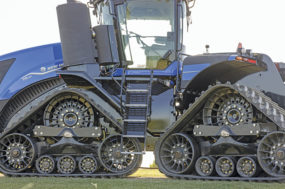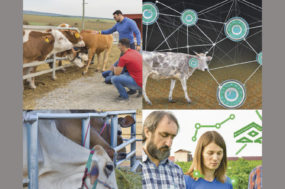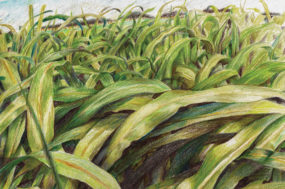As a byproduct of this evolution, forage analysis has become more complex and informative to the end user.
However, when trying to interpret forage analysis reports, it’s important to know where our knowledge begins and, just as importantly, where it ends.
This article will highlight some of the valuable information within a report and some of the common pitfalls of interpretation.
Calculations
Forage analysis reports often include a combination of nutrients which are measured and calculations based on those nutrients.
Common calculations include total digestible nutrients (TDN), net energy for lactation (Nel), net energy for gain (Neg), net energy for maintenance (Nem), relative feed value (RFV) and relative forage quality (RFQ).
On their own, each of these calculations provides valuable information about the nutritional value of the forage.
Nel, Neg and Nem, for example, are estimates of the amount of energy a forage will contribute to an animal’s diet.
However, as the science of ruminant nutrition has evolved, so have the calculations for Nel, Neg and Nem.
Early equations were calculated solely from the ADF content of a feedstuff, then summative equations were created that included protein, fat, fiber, carbohydrates and ash.
Now some calculations for energy even include an adjustment for NDF digestibility and kernel processing.
Users should be cautious when comparing these calculations, as the choice of which calculation to use will largely determine the number produced.
For example, the Nel calculation for a hay sample may be 0.54 megacalories (Mcal) per pound for the OARDC summative equation, but 0.64 Mcal per pound for a calculation based only on ADF.
Perhaps the most common calculation, RFV is a calculation based on the amount of fiber in a forage sample.
This index has been used for many years to compare the nutritional value of hay and has developed into a tool for buyers and sellers of forage.
However, one of the things RFV does not account for very well is the digestibility of fiber. This can become a problem when comparing hays with varying amounts of grass, as grass tends to have higher fiber digestibility than legumes.
In recognition of the importance of fiber digestibility, RFQ was created. This index is on the same scale as RFV with an adjustment for fiber digestibility (NDFD), and is an excellent tool for comparing hays with varying amounts of grass and legume contents.
Unfortunately, the analytical procedure for NDFD requires live animals and is largely dependent on the diets which these animals are fed, so standardizing NDFD across labs is nearly impossible.
This means NDFD cannot be compared directly across labs and comparison of RFQ across labs is murky at best.
Biological assays
One of the trends in current forage analysis is a move from traditional chemical assays to biological assays that use the microbes present in rumen fluid to measure the digestibility of feedstuffs.
Among these assays are NDFD (24-hour, 30-hour, and 48-hour), in vitro starch digestibility (IVSD 2 to 8 hours), microbial soluble protein and a variety of gas production analyses.
These analyses are a huge step in making the connection between lab measurements and animal performance.
Mainly, they allow us to ask rumen microbes what they think of the feedstuff we are testing, and since they are the ultimate judges of a feed’s nutritional value, this line of analysis makes sense.
One of the limitations to these analyses is that the amount of feed digested depends not only on the feedstuff but also on the rumen fluid used to test the feed.
Naturally, nutritionists tend to be more interested in the value of their feed sample than the value of our rumen fluid in the laboratory, so we take many precautions to make sure the feed sample, and not the rumen fluid, is the limiting factor in the measured digestibility of a feed sample.
However, the rumen fluid in cows on a conventional farm is very unlikely to have these same advantages. The take-home point here is that in vitro digestibilities should be seen as the maximum attainable value for a feed, not the absolute value which will be obtained on the farm.
It’s also worth reiterating here that the quality of rumen fluid is largely dependent on the diet that donor animals consume.
This factor alone makes standardizing biological assays across labs nearly impossible. While well-run laboratories should rank forages similarly, the absolute values in biological assays should not be compared across labs.
NIR
Near-infrared spectroscopy (NIR) has been one of the greatest advancements in the history of forage analysis.
This technology has greatly improved animal and crop production in general and it would be appropriate to recognize here that we are all indebted to the recently deceased Dr. John Shenk, who worked tirelessly to bring the benefits of NIR into mainstream agricultural practice.
Scientifically, it uses the light reflected by a set of known samples to predict the nutrient value of unknown samples. Practically, it allows for rapid, repeatable and inexpensive evaluation of feedstuffs.
That said, NIR is not equally capable of predicting all nutrients. For example, NIR does very well at predicting the crude protein value of a forage because all it has to detect is the amount of nitrogen in a sample.
Nitrogen has a very consistent chemical structure, so it is easily detected. In comparison, the traditional analysis for fat (ether extract) includes not only fat but anything that dissolves in ether including waxes, chlorophyll, urea, glycerol, pigments and fat-soluble vitamins.
Asking NIR to combine all these constituents into one prediction is very difficult and NIR predictions for ether extract fat are less accurate due to these variables.
NIR also relies heavily on a database of samples with known wet chemistry values, and the structure of that database influences NIR’s ability to predict new sample values.
For forages, this means databases need to be constructed on a wide variety of samples spanning several growing seasons and growing environments.
This also means databases are very expensive to construct, and laboratories are unlikely to maintain robust calibrations for obscure forages.
If accurate nutrient values are needed for rare or unusual forages, it is best to order a wet chemistry analysis.
This rule applies not only to rare species but also to common forages if they contain very high levels of mold, dirt or are extreme in other ways.
Some labs will inform you when your sample is an “outlier” from their database and will run wet chemistry at no charge. Other labs may be less prudent in this area and assume you understand the limitations of their databases.
Conclusion
Forage analysis is a powerful tool that provides users with information about the value and variation within their feedstuffs but, like most power tools, it works best in the hands of people who understand its purpose and limitations.
NIR, biological assays and calculations all provide value to producers who grow or feed forages. Understanding the strengths and limitations of each of these tools will help users maximize their value and draw sound conclusions from forage analysis reports. FG

Kyle Taysom
Dairyland Laboratories Inc










